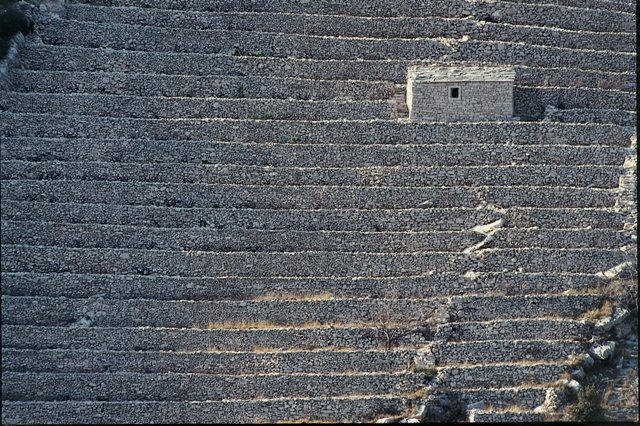A dry stone wall, fence or suhozid is a structure made of natural stone without the use of a binding material such as mortar. The construction of dry stone walls, and other structures made without mortar, demand special skills and traditions handed down over generations. They are a significant part of the cultural heritage of the greater Mediterranean area stretching back to ancient times.
In prehistoric times when neolithic farming took hold in the European hinterland, former cave-dwelling people built their homes, fences and animal shelters using wood. Meanwhile, in southern Europe and along the Mediterranean, wood was in large part difficult to find, and due to frequent droughts and resulting wildfires, wooden structures were also impractical. Different building techniques developed in these areas which took advantage of the plentiful stone harvested from the rocky terrain.
It was in this way that dry stone construction began to shape Dalmatia and the structures which dominate the area even today. In addition to walls, the technique was used to build small dwellings; fences encircling vineyards, arable land and pastures; and in the construction of wells. The Premužić trail, a 57 kilometre-long path cutting through the highest peaks of northern and central Velebit, is yet another famous example of mortarless architecture. Further advantages of this type of construction is that they protect against soil erosion and serve as shelter for various plants and animals; including, lizards, snakes, frogs, bees and insects.
Dry wall construction is a reflection of the diligent and often hard life of the locals who collected the stones from the environment to use in the myriad structures. But by doing so, agricultural land and living space for animals would be cleaned of cumbersome stone. When building any dry stone structure, it is of extreme importance to select the proper stones and have them interlock accordingly to ensure durability and stability.

Photo by Andrija Carli
When we talk about dry stone constructed shelters in Croatia, our attention must be turned to the kažun in Istria, the komarda in the Kvarner region, bunja in Dalmatia and trim on the island of Hvar. These circular-shaped huts and their conical or stepped roofs were originally used as dwellings for people, but later shifted their purpose to house agricultural tools, farm equipment, and ultimately as emergency shelters for shepherds to take refuge from a passing storm.
If you wish to see examples of dry stone walls in the city of Split, look no further than Marjan park. The city’s forested park is intertwined with a network of mortarless walls and fences that cover nearly the entire surface of the park. It is also possible to run into examples of the circular field houses typical of Dalmatia mentioned earlier.
In order to preserve and maintain this traditional form of construction, the Dragodid project was launched. The project aims to study the different types of traditional mortarless constructions and to make sure that the skills and building methods are not forgotten. Dry stone workshops are organized whereby participants can learn traditional building techniques.
The peak seasons for dry stone construction in Dalmatia are the spring and fall. Construction subsides slighly during the summer because the days are too hot. If anyone is interested in participating in one of the workshops, information can be found on www.dragodid.org or FB page.
Fun fact:
The Great Wall of China is widely considered to be the longest wall in the world. But there is a lesser-known one which is in fact even longer: located in the Croatian region of Dalmatia. This wall is none other than the endless dry stone walls that encircle Dalmatia’s countless vineyards.





Comments